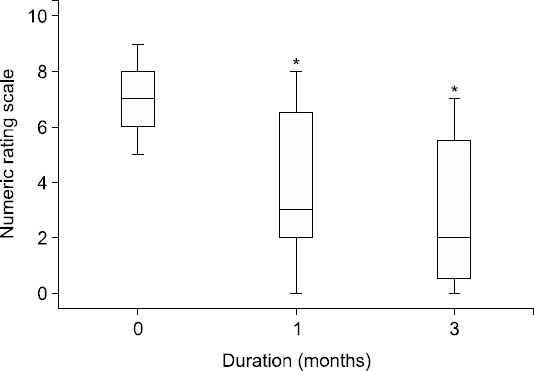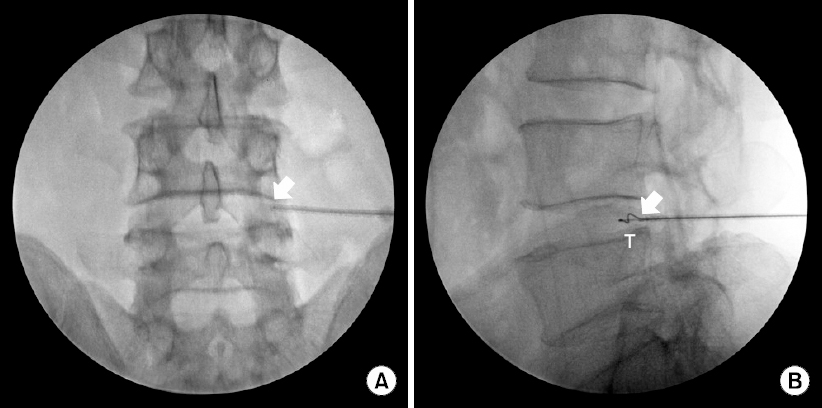1. Andersson GB, Brown MD, Dvorak J, Herzog RJ, Kambin P, Malter A, et al. Consensus summary of the diagnosis and treatment of lumbar disc herniation. Spine (Phila Pa 1976). 1996; 21(24 Suppl):S75–8. DOI:
10.1097/00007632-199612151-00009.
2. Manchikanti L, Abdi S, Atluri S, Benyamin RM, Boswell MV, Buenaventura RM, et al. An update of comprehensive evidence-based guidelines for interventional techniques in chronic spinal pain. Part II: guidance and recommendations. Pain Physician. 2013; 16(2 Suppl):S49–283. PMID:
23615883.
3. Long DM. Surgery for back and neck pain (including radiculopathy). Wall & Melzack’s textbook of pain. 6th ed. McMahon SB, Koltzenburg M, Tracey I, Turk DC, editors. Philadelphia: Elsevier Saunders;2013. p. 1012–27.
4. Manchikanti L, Singh V, Pampati V, Falco FJ, Hirsch JA. Comparison of the efficacy of caudal, interlaminar, and transforaminal epidural injections in managing lumbar disc herniation: is one method superior to the other? Korean J Pain. 2015; 28:11–21. DOI:
10.3344/kjp.2015.28.1.11. PMID:
25589942. PMCID:
PMC4293502.
5. Kang H, Shin HY. Epidural steroid injection in spinal pain: a study on the NECA report. Anesth Pain Med. 2014; 9:9–18.
6. Lurie JD, Tosteson TD, Tosteson AN, Zhao W, Morgan TS, Abdu WA, et al. Surgical versus nonoperative treatment for lumbar disc herniation: eight-year results for the spine patient outcomes research trial. Spine (Phila Pa 1976). 2014; 39:3–16. DOI:
10.1097/BRS.0000000000000088. PMID:
24153171. PMCID:
PMC3921966.
10. Rohde V, Mielke D, Ryang Y, Gilsbach JM. The immediately failed lumbar disc surgery: incidence, aetiologies, imaging and management. Neurosurg Rev. 2015; 38:191–5. DOI:
10.1007/s10143-014-0573-3. PMID:
25242202.
11. Shamim MS, Parekh MA, Bari ME, Enam SA, Khursheed F. Microdiscectomy for lumbosacral disc herniation and frequency of failed disc surgery. World Neurosurg. 2010; 74:611–6. DOI:
10.1016/j.wneu.2010.06.016. PMID:
21492628.
12. Chen Y, Derby R, Lee SH. Percutaneous disc decompression in the management of chronic low back pain. Orthop Clin North Am. 2004; 35:17–23. DOI:
10.1016/S0030-5898(03)00052-X.
13. Bartsch T, Goadsby PJ. Increased responses in trigeminocervical nociceptive neurons to cervical input after stimulation of the dura mater. Brain. 2003; 126:1801–13. DOI:
10.1093/brain/awg190. PMID:
12821523.
14. Lee SH, Derby R, Sul Dg, Hong Jw, Kim GH, Kang S, et al. Efficacy of a new navigable percutaneous disc decompression device (L’DISQ) in patients with herniated nucleus pulposus related to radicular pain. Pain Med. 2011; 12:370–6. DOI:
10.1111/j.1526-4637.2011.01064.x. PMID:
21332936.
15. Singh V, Manchikanti L, Benyamin RM, Helm S, Hirsch JA. Percutaneous lumbar laser disc decompression: a systematic review of current evidence. Pain Physician. 2009; 12:573–88. PMID:
19461824.
16. Mirzai H, Tekin I, Yaman O, Bursali A. The results of nucleoplasty in patients with lumbar herniated disc: a prospective clinical study of 52 consecutive patients. Spine J. 2007; 7:88–92. DOI:
10.1016/j.spinee.2006.02.033. PMID:
17197339.
17. Amoretti N, David P, Grimaud A, Flory P, Hovorka I, Roux C, et al. Clinical follow-up of 50 patients treated by percutaneous lumbar discectomy. Clin Imaging. 2006; 30:242–4. DOI:
10.1016/j.clinimag.2006.01.019. PMID:
16814138.
18. Manchikanti L, Singh V, Calodney AK, Helm S 2nd, Deer TR, Benyamin RM, et al. Percutaneous lumbar mechanical disc decompression utilizing Dekompressor
®: an update of current evidence. Pain Physician. 2013; 16(2 Suppl):SE1–24. PMID:
23615884.
19. Lemcke J, Al-Zain F, Mutze S, Meier U. Minimally invasive spinal surgery using nucleoplasty and the Dekompressor tool: a comparison of two methods in a one year follow-up. Minim Invasive Neurosurg. 2010; 53:236–42. DOI:
10.1055/s-0030-1269860. PMID:
21302191.
21. Ong D, Chua NH, Vissers K. Percutaneous disc decompression for lumbar radicular pain: a review article. Pain Pract. 2016; 16:111–26. DOI:
10.1111/papr.12250. PMID:
25354274.
22. Vorobeychik Y, Gordin V, Fuzaylov D, Kurowski M. Percutaneous mechanical disc decompression using Dekompressor device: an appraisal of the current literature. Pain Med. 2012; 13:640–6. DOI:
10.1111/j.1526-4637.2012.01367.x. PMID:
22494347.
23. Boswell MV, Trescot AM, Datta S, Schultz DM, Hansen HC, Abdi S, et al. Interventional techniques: evidence-based practice guidelines in the management of chronic spinal pain. Pain Physician. 2007; 10:7–111. PMID:
17256025.





 PDF
PDF Citation
Citation Print
Print




 XML Download
XML Download